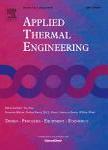版权所有:内蒙古大学图书馆 技术提供:维普资讯• 智图
内蒙古自治区呼和浩特市赛罕区大学西街235号 邮编: 010021

作者机构:Natl Inst Adv Ind Sci & Technol Energy Technol Res Inst Turbomachinery Grp Tsukuba Ibaraki 3058564 Japan Natl Inst Adv Ind Sci & Technol Energy Technol Res Inst Socioecon & Policy Study Grp Tsukuba Ibaraki 3058564 Japan Natl Inst Adv Ind Sci & Technol Energy Technol Res Inst Thermal & Fluid Syst Grp Tsukuba Ibaraki 3058569 Japan Natl Inst Adv Ind Sci & Technol Energy Technol Res Inst Tsukuba Ibaraki 305 Japan Kanagawa Inst Technol Dept Vehicle Syst Engn Atsugi Kanagawa 2430292 Japan
出 版 物:《APPLIED THERMAL ENGINEERING》 (实用热力工程)
年 卷 期:2014年第70卷第1期
页 面:705-715页
核心收录:
学科分类:0820[工学-石油与天然气工程] 080702[工学-热能工程] 08[工学] 0807[工学-动力工程及工程热物理] 0802[工学-机械工程] 0801[工学-力学(可授工学、理学学位)]
主 题:Cogeneration system Micro gas turbine Latent heat storage Phase-change material University Programmable logic controller Temperature control schedule CO2 reduction Efficiency
摘 要:The latent heat storage system is a novel heat storage system. At the University under service conditions, it was demonstrated with a micro gas turbine (MGT) cogeneration system (CGS). Expanding the latent heat storage system into new applications is expected to save energy economically with high density energy storage and reduce exhaust emissions and reduce operational costs. This is the first demonstration of using a latent heat storage system with CGS under service condition and its characteristics are very important. In Part I, a fixed operating schedule of the system was planned and demonstrated at the University. The charge/discharge cycles of the latent heat storage system were repeated for 407 times. The energy flow test of the system shows the importance of the heat release source and total system design. In Part II, an irregular charge case of the latent heat storage system was discussed when the prime mover of the system was operated at a part load and thermal priority mode. A highly sophisticated system design that solves these problems was necessary for extending the applications of the latent heat storage system. In Part III, a temperature control schedule of the system was demonstrated during winter mornings using a new programmable logic controller (PLC). Using a fixed schedule, the MGT-CGS with latent heat storage reduced the CO2 emission when the energy utilization factor was above 50%. The temperature control schedule was considered to be better than the fixed schedule, both in terms of the operational efficiency of the overall system and CO2 reduction. The temperature control schedule was executed using an empirical formula for the temperature rise in a classroom. The restriction on the operation time by the contract with the gas supplier and the low heating capacity of the CGS affected the heating time and temperature rise. The temperature rise in the classroom was almost proportional to the integrated temperature difference across the hot water